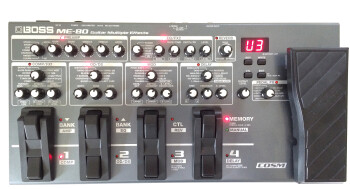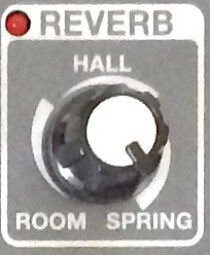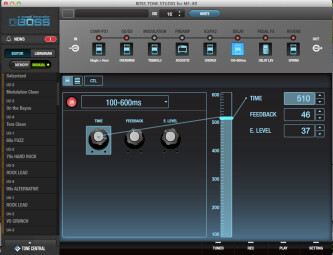For years, Boss has been one of the leading manufacturers of self-contained guitar multi-effects floor units, and the ME-80 is its latest effort. Less expensive than the flagship GT-100, it's nevertheless a very capable and fully featured unit. The ME-80 gives you access to virtually any kind of guitar effect, a range of preamp sounds, an expression pedal with many effects choices, and even a built-in looper, all in one unit. Let’s take it for a test drive.
Look around
At a little under 18” wide and just over 9” deep, the ME-80 features four cleverly designed dual pedals that each have a top and bottom footswitch. Add in the expression pedal, which has footswitching capabilities of its own, and there’s plenty of foot control for the unit’s eight simultaneous effects modules. Contrast that to its predecessor, the ME-70 — it can have eight effects at a time, but only has four footswitches and an expression pedal.
Each of the four pedal housings has a top and a bottom footswitch, which is how eight pedals can fit on the frame without being crowded. The top panel also sports an expression pedal that defaults to volume control, but can be switched with a press of a toe switch to wah, “Whammy”-style pitch shifting, realtime parameter control, and more.
Above the line of pedals are numerous control knobs, arranged in clusters representing the eight different effects modules. Each module has anywhere from 3 to 11 choices, and all told the ME-80 offers 72 different effects! (Try fitting 72 stompboxes on a pedalboard.) The diversity of effects is staggering. You name an effect type, it’s probably on the ME-80.
One weak aspect is the paltry 2-character, 7-segment LED. A display this small on a unit this complex is barely adequate. For example, when you select a patch, the display only shows you what bank it’s in, and you have to look down to the status light on the individual pedal to see whether it’s patch 1, 2, 3, or 4 in that bank. The patch number is something you should be able to see at a glance.
The modules include Preamp, Comp/FX1, OD/DS (overdrive/distortion), Mod, EQ/FX2, Delay, Reverb and Pedal FX. Along with its status light, each module has a detented selector knob, along with rotary parameter knobs. Each knob’s function — or functions, as many have more than one — is labeled in white writing, which contrasts nicely to the gray metal of the unit’s body, and the darker gray heavy-duty plastic switches and expression pedal.
The back of the unit features a 1/4” Guitar Input, a stereo pair labeled 1/4” Guitar Amp Outputs, a 1/8” Aux In for connecting an external audio player for practice or to provide backing tracks, and a 1/8” Rec Out/Phones output, whose signal passes through an amp simulator. In the ME-80's default state, the signal passing through the 1/8” output features the amp simulator, but what comes out of the Guitar Amp Outputs doesn’t (these settings are changeable, however).
A USB port allows for connection with your computer (Mac or PC), which I’ll go in to a little later in the review. Next to it is an on/off switch, a DC In jack lets you connect an optional Boss PSA-120S AC adapter, and finally, a post for attaching an (optional) Kensington security cable.
Underneath the unit is the cover for the battery compartment, which holds six AA batteries (included). Boss states in the manual that you can get up to seven hours on one set of alkaline batteries, and while I can’t confirm that exact number, I’ve been surprised how long they’ve lasted. I’ve done a fair amount of testing of the unit, and brought it to two band rehearsals, and the batteries are finally just starting to run low. That said, if you’re going to use the ME-80 for regular gigging, it’s much more cost effective over time to shell out the $21.99 for the PSA-120S adapter.
Modality
The ME-80 also has a built-in tuner, which is pretty stable, but thanks to the minuscule display, it’s not as easy to use as you’d expect on a unit this sophisticated. You only one left and one right arrow to show flat and sharp, respectively, and the note name in the display, making it harder to gauge the distance that the note you’re tuning is from the target pitch, and thus causing a lot of over- or under-compensating when turning your tuning machines.
The ME-80 has two modes: When it’s in Memory mode, pressing the pedals switches between presets and banks. When it’s in Manual mode, the pedals turn on and off individual effects. The problem is that if you dial in a patch in Memory mode, and then switch to Manual mode hoping to turn its effects on and off individually, the unit reverts to the setting you had the last time you were in Manual mode, rather than keeping the patch you just dialed up in Memory mode. To me, it would be a lot more useful to be able to choose a preset in Memory mode, and then be able to switch to Manual mode to turn things on and off. That way, you could program a preset for a given song, and then switch to Manual mode if you want to say, turn the chorus on or off during that song.
Luckily, there is a workaround: reach down and press the Edit button while in Memory mode (you have to use your finger because it’s not a footswitch), at which point you can turn on and off effects and edit them while keeping the settings from the current Memory mode preset.
Effectiveness
So, let’s take a look at the effect structure. Each of the eight effects modules is mainly dedicated to a particular effect type. I say mainly, because Boss has cleverly repeated some of the effects in more than one module. Why? Because it’s possible you’d want more than one Modulation effect on at a time, and if they were exclusively clustered in one module, you could only have one. So common effects like Chorus, Phaser, Tremolo and Delay can be found in two different places, providing you with a lot more flexibility in how you put together effect combinations.
The Preamp module lets you select between nine different COSM preamp models including Clean, Tweed, Crunch, Combo, Lead, Drive, Stack, Metal and AC (which is for acoustic-electric guitar sounds). Gain, Level, Bass, Middle, and Treble knobs, are available for tone shaping. My favorite preamp models were probably Tweed and Crunch. Here’s an example of the Tweed model with the T-Scream overdrive effect on. (All sound examples in this review were recorded on an ESP 400 series Strat-style guitar with Lace Sensor pickups through a blackface Fender Twin Reverb reissue and miked with a Shure SM-57.)

Some of the preamps sounds were a little “digital” sounding for my taste. Not surprisingly, the ME-80’s preamp sounded a lot better when played through a tube amp, as compared to a solid-state one. The other thing to remember is that assuming you’re connecting through a guitar amp, you don’t necessarily need to have the preamp section turned on at all. I got some excellent tones with the preamp section off, and using the OD/DS for crunch and distortion, while taking advantage of the other effects the unit has to offer.
The next module is Comp/FX1, which has a range of effects in it including a nice sounding compressor, two auto wah choices, an excellent sounding octave divider that lets you blend in an either a one- or two-octave-below pitch shift, Slow Gear, and Defretter, the latter of which is supposed to make your guitar sound fretless. It doesn’t really do that all that well, but does provide some interesting, almost sitar-like tones. Also in that module is a Ring Modulator, AC Sim, a nice acoustic simulator, and Single Coil to Humbucker and Humbucker to Single Coil effects that are ok at best. The Solo effect is not well explained in the module, but seems to include a volume boost for soloing.
The OD/DS module is impressive, and not only features models of Boss’s classic pedals like the OD-1, BD-2 Bluesdriver, OD-2 Turbo OverDrive, MT-2 Metal Zone, ML-2 Metal Core and Boss DS-1 Distortion, but also emulations of the Ibanez Tube Screamer, Electro-Harmonix Big Muff, and the Otavia pedal of Jimi Hendrix fame, and a (Gain) Boost. Overall, it gives you a nice selection of overdrive and distortion, with Drive, Tone, and Level control over each.
The Mod module is another powerhouse, offering Boss versions of Pitch Shift (plus or minus 24 semitones), Chorus, Phaser, Flanger, Tremolo, Vibrato, Harmonist (which lets you set a key and an interval for harmonizing single-note lines), Uni-V and Rotary, all of which sound really good. The Overtone effect produces a 12-string-like tone.
The EQ/FX2 module gives you Bass, Middle and Treble controls, but can instead be set to Chorus, Delay, Boost, Tremolo or Phaser.
The Reverb Module consists of a single knob, which is divided into three sections: Hall, Room, and Spring. There are three visible lines around the knob, one for each reverb type. Each starts thin and gets gradually wider, and the amount of reverb increases in relation to the width. Although the manual implies that you’re adjusting room size, it seems more like a wet/dry mix to my ears. In any case the reverbs sound good, but I would have liked a little more parameter control.
The Delay module offers a wide selection. First, there are several settings that bring up digital delays with different delay time ranges, which can then be fine tuned with the Time knob. Then there are analog and tape delay emulations, which sound good, but have maximum delay times that sound like they’re only about 300 ms, which isn’t long enough, in my opinion. Other delay options include a modulated delay; a very cool reverse delay; a spacey delay/reverb combo called Terra Echo; which is cool-sounding, but not an everyday effect; and even a basic looper, with 38 seconds of total looping. I was happy to discover that delay times, and most of the speed settings on the modulation effects, can be set via the Tap Tempo feature.
The final module is called Pedal FX, for selecting the various modes of the expression pedal. The default is volume, but if you press down on the pedal’s toe switch, you can choose from Wah; 1-octave up, 2-octave up, and 1-octave down “whammy” style effects; Freeze, which sustains a note with the pedal down, allowing you to play over it; OSC Delay, an oscillating delay effect that’s not particularly musical, but more of a special effect. But that’s not all, you also get three real-time control settings, which are quite cool and useful: OD/DS sets the pedal to control the amount of Drive any of the overdrive or distortion effects; Mod Rate controls speed of any of the modulation effects; and Delay Level, for controlling Wet/Dry level for whichever delay you have set. Having a pedal for real-time control is really a cool feature.
Here’s an example of the “Whammy” style, +1 octave effect:



An adjustable noise suppressor is also included on the ME-80. You wouldn’t know about it unless you read the manual, however, as it requires a particular combination of button presses to reveal it. Due perhaps to the small display, there are a lot of hidden settings, which you won’t know about, or how to access, until you read the manual (which, for a Boss manual is pretty clear and well-written).
USB for you and me
On top of all those features, the ME-80 can connect to a Mac or PC via USB, once you’ve downloaded the drivers and the free BOSS Tone Studio for ME-80 software, which gives you an onscreen editor and librarian. You can use it to easily edit patches, and save them to the computer or the unit, as well as create Live Sets of patches to export to banks on the ME-80. The software is well designed, and also includes a nice onscreen tuner, a recorder module, and a link to Boss Tone Central, where you can download patch collections from celebrity guitarists, as well as additional ME-80 banks.
The USB connection allows you to record directly into your DAW. If your DAW doesn’t allow you to set a different input and output, you can monitor both the signal being recorded and the tracks coming back from your DAW through the ME-80s headphone output, or through the two Guitar Outputs.
The comparison
To get some context and help judge the sound of the ME-80, I decided to compare it against similar effects and settings on my analog pedal board. On the ME-80, I used the Clean preamp, the T-Scream overdrive setting and the compressor.
Here’s a chunky rhythm sound on the ME-80:

From my pedalboard, I used a Boss CS-2 compressor, and an MXR GT-OD overdrive pedal, which is similar to a Tube Screamer. I matched the settings ac closely as possible to what I’d used on the ME-80, and recorded the same type of chunky rhythm part.

Next I tried the same setups but with lower gain settings.
First, the ME-80:

Now the pedalboard:

Finally, I compared both with just their compressors on.
Here’s the ME-80:

And the pedalboard with a similar setting:

While it was far from a scientific comparison, it was illustrative. Although the analog pedalboard effects definitely had more body, particularly on the crunchy example, the differences weren’t as big as I expected. That said, the ME-80's sonic character is pretty variable, depending on its preamp setting, but when judiciously set, it can sound quite good.
Change of heart
I have to say I was pretty skeptical of this unit at first, and it definitely took me a while to get to where I was comfortable with its architecture. But I have really come around, after seeing all that it can do. There’s no way you’d ever be able to buy the individual stomp boxes necessary to equal what’s offered on the ME-80 ($299), without spending many times over what it costs. Other than the rather meager display, I think the ME-80 is well thought out and offers infinite sonic possibilities.
From a convenience standpoint, the ME-80 is clearly superior to a pedalboard with individual stompboxes. Not only do you get the massive effects collection, but the ability to save user presets, USB connectivity and the convenience of a single, relatively compact unit that’s easy to setup and take down, and doesn’t require the upkeep of a pedalboard.
No, I won’t be giving up my analog effects for recording, but for live, I’m seriously considering the ME-80.




